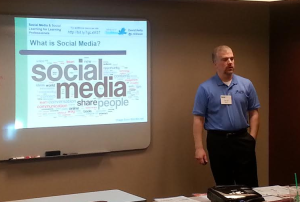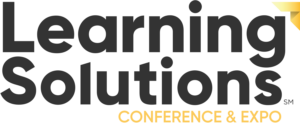 Earlier this week I had the pleasure of speaking at the local Long Island ASTD Chapter meeting. The topic of my talk was Social Media and Social Learning for Learning Professionals.
Earlier this week I had the pleasure of speaking at the local Long Island ASTD Chapter meeting. The topic of my talk was Social Media and Social Learning for Learning Professionals.
It was the type of speaking engagement I really enjoy, as it was less of a presentation and more of a discussion. I usually start with an loose agenda and plan for my content and message, and then adapt it on-the-fly based on the expressed needs of the audience and how the discussion evolves. Last night the discussions were vibrant, thought-provoking, and reflective which as a speaker, is exactly what I want. About 2/3 of the way through the session it became apparent to me that we were not likely to get through all of the content we planned for. I am not someone who will race through content and slides as time draws short to make sure I cover everything – it’s a colossal waste of time. I would rather cover less content in a meaningful way then race through information in a meaningless way.
So we paused for moment and made a group decision to keep the discussion continue at the pace it was without worrying about “covering everything”. I also committed to sharing information on the content areas we didn’t cover in the discussion via an entry on my blog – and that’s the post your reading now.
All of the resources from the session, including slides, articles, and more, can be found HERE. Here are some additional pieces of the discussion we didn’t have time to explore last night:
Social Media Branding
One of the failures I see many colleagues making when it comes to social media is not understanding the value of your brand. In today’s digital world, all of the interactions you have online are contributing to a brand people associate with you. For many people, this brand is something that happens as a result of the interactions they have online.
That’s a mistake. In fact, it’s completely backwards.
Those who understand branding and social media don’t allow their interactions to create a brand; they have a vision for what their brand should be and then ensure they interact in ways that support that vision.
In today’s world you have to think strategically about social media and what sort of image you are creating for yourself. Your social media interactions form a trail of breadcrumbs that tell people who you are,and what’s important to you.
I can’t tell you what your brand should be; I can only remind you that you have one, and that you need to be conscious of it.
For more about branding, check out this older post about how I developed my personal social media strategy. It’s a little dated (3 years), but the story contained in the post still applies.
Overcoming Objections to Using Social Media
One of the questions we could not dive deeply into was about how to overcome objections senior leaders have related to using social media for learning. This is a tough challenge to overcome, mostly because it’s not an issue of technology or social media; usually it’s a challenge of culture.
Using social media for learning and performance purposes goes against a very deeply embedded cornerstone of training: The need for control. Organizations are very comfortable with the model of a knowledgeable and vetted expert (at least perceived that way) sharing approved information with novices. That’s a very safe model.
When you use social media tools for learning, those rules go out the window, or at least they should. Jane Bozarth likes to talk about the “Hey Joe” method of learning, which is essentially what happens multiple times every workday. A worker hits a performance hurdle, pokes his or her head over the cubicle wall and says “Hey Joe, can you give me a hand for a minute?”.
That’s where the majority of learning and performance improvement takes place anyway, in the normal activities of a day, in the overcoming of obstacles and the solving of problems. Social media tools take the “Hey Joe” method and supercharges it, allowing you to poke your head over the cubicle wall of any co-worker – or anyone for that matter – anywhere on the planet.
Case in point – earlier today I was working on a presentation I’m giving in a few weeks on the topic of Google Glass. I want to give a live demo of Glass functionality, but that traditionally involves wifi – something I am not sure I can count on where the conference is taking place. I needed a non-wifi solution.
In this situation most people would use Google to find a solution. I love Google, but in situations like this Google is not my primary resource; Social Media is. When you have a strong community connected by social media, you can get answers that Google can not give you, answers that have the context of shared experiences (community, culture, job role, etc).
I posted my question to Twitter…
Within five minutes I received three responses from people that contained not only suggestions, but also context as to why they made the suggestion. Some even shared links to YouTube videos that showed the solution being implemented.
I also posted the question to a smaller network of peers I interact with regularly. A few people tried to help, and a short conversation took place. A suggestion was made, I added additional context as to why that suggestion would not work, and additional suggestions were made. That conversation not only helped me learn, but the collaborative problem solving helped those trying to help me learn as well.
And oh yeah… since that threaded discussion took place on social media, it can serve as a resource for people to reference at a later date.
It might seem like I’m getting away from the core question – “How do you overcome objections” – but it is related. I find that most people that object to social media tools for learning fail to understand how these networks really work, and therefore can not possibly comprehend how they could be used to help an organization perform better.
That’s where stories like I just shared come in. Any time a story comes up in which a social media tool was used to solve a problem, that story needs to be shared. It’s evidence and a very real example of how these tools can help an organization perform better.
People always object to things they don’t understand, so help them understand.
One more tip on objections – start something small with a few people, perhaps a project team. It’s a great way to generate the stories you need to help people understand ow it can help on a larger scale.
Power Tools
The last topic we didn’t get to cover was about tools that can help you take social media usage to the next level. Before I share a few, a few words of caution. The point of social media, especially as it relates to learning, is to engage others and to interact with them. I do not recommend people move on to power tools until they are comfortable being an active participant in social media conversations in general.
With that disclaimer out of the way, here are a few tools I like.
HootSuite: Hootsuite enables users to follow multiple networks at once, including facebook, Twitter, LinkedIn, and more. It’s a great way to monitor all of your social feeds in a single place, though it can also be overwhelming to someone that isn’t ready for it.
Socialoomph: I really like this service for it’s ability to schedule dates and times for updates to be posted. HootSuite also does this, but I find Socialoomph to be more user friendly for this purpose. Another disclaimer: Scheduling updates for times you are not available to interact with responses to the updates limits interaction. My primary reason for scheduling updates in advance is when I’m organizing a Twitter Chat.
IFTTT (If This Then That): This is a great service that can do some amazing things with social media. It’s a simple, trigger-based system that automates actions. For example, here are a few triggers I have set up on IFTTT:
- If I post a picture to Instagram, save the picture to DropBox
- If I check in on Foursquare, add a note for the checkin on Evernote
- If I publish a post on my blog, post the title and a link for the post on Twitter
These are just a few of the countless triggers that can be set up using IFTTT.
For more detailed information about different social media tools, I highly recommend socialcompare.com
More questions?
Have more questions about social media and/or social learning? Feel free to pose them in the comments of use the Contact Me option of this website to reach out to me directly.








